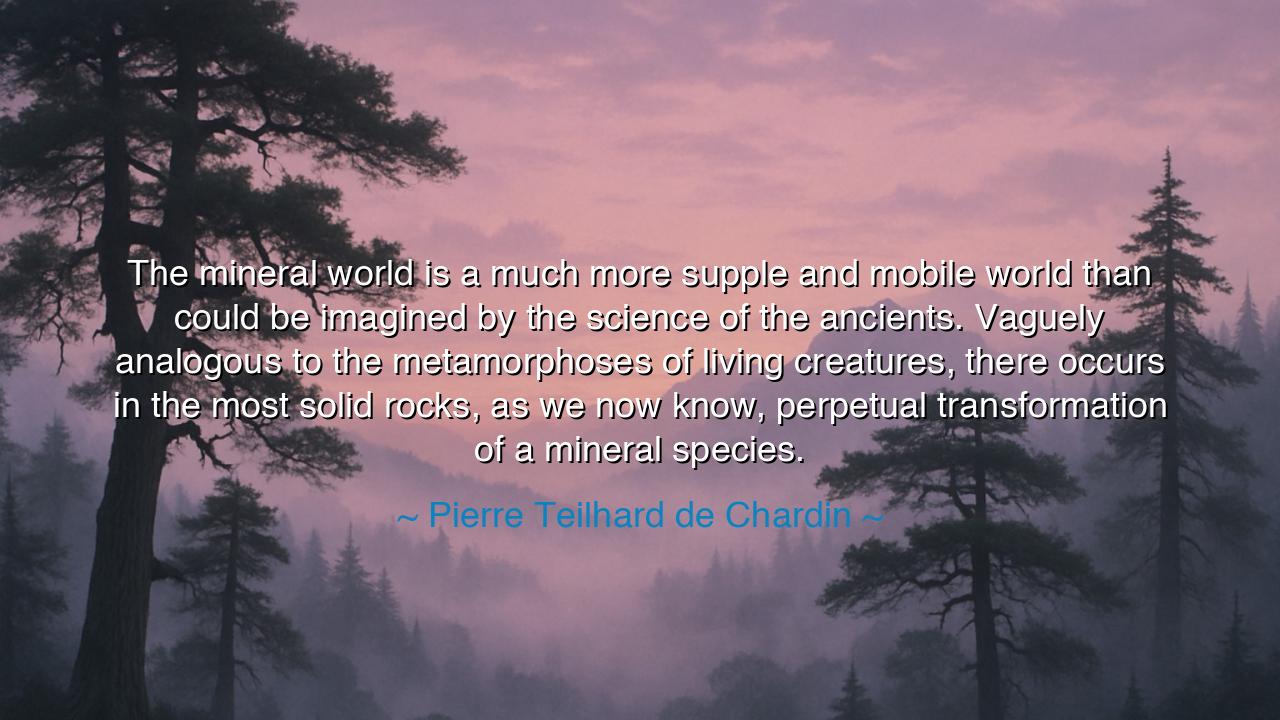
The mineral world is a much more supple and mobile world than
The mineral world is a much more supple and mobile world than could be imagined by the science of the ancients. Vaguely analogous to the metamorphoses of living creatures, there occurs in the most solid rocks, as we now know, perpetual transformation of a mineral species.






“The mineral world is a much more supple and mobile world than could be imagined by the science of the ancients. Vaguely analogous to the metamorphoses of living creatures, there occurs in the most solid rocks, as we now know, perpetual transformation of a mineral species.” Thus spoke Pierre Teilhard de Chardin, priest, philosopher, and scientist, who gazed upon the Earth not as a dead stone beneath our feet, but as a living, changing reality. His words remind us that the very bones of the Earth are not fixed and motionless, but shifting, growing, and evolving, just as life itself does. To the ancients, stone was permanence and rock was eternity. To Teilhard and to us, they are alive with transformation.
The origin of these words is in Teilhard’s lifelong union of science and spirit. As a paleontologist, he studied the history of life embedded in the layers of the Earth. He came to see that the mineral world, though seemingly unyielding, was in truth in constant motion—melted by fire, crushed by pressure, dissolved by water, re-formed into crystals and ores. What had seemed immutable to the ancients revealed itself as a world of restless change. Rocks, like creatures, undergo a kind of metamorphosis, moving from one form to another across the ages, shaped by forces both subtle and vast.
Consider the great cycle of mountains. The Himalayas, highest of earthly peaks, were once the floor of a sea. Shells and corals that dwelt beneath the waters now rest upon the summits, lifted skyward by the slow clash of continents. What could seem more immovable than a mountain? Yet even mountains rise and fall, their stones ground to sand, their sand pressed again into stone. Teilhard saw this and declared: even in the most solid rocks, there is life’s rhythm of death and rebirth, transformation without end.
History also shows how the ancients misunderstood this truth. To them, marble and granite were eternal, the foundations upon which temples and statues defied the ages. Yet time proved otherwise. The pyramids erode, the Parthenon crumbles, and even the hardest rock is worn down by wind and rain. Only in modern geology did mankind awaken to the profound truth Teilhard exalts: that the Earth itself is a living book, written not in stillness but in perpetual motion. In the slow dance of minerals, we glimpse a mirror of our own mortality and renewal.
The lesson of Teilhard’s words is not only geological but spiritual. He reminds us that nothing in the cosmos is truly still. Just as rocks flow through their cycle of metamorphosis, so too do human lives, societies, and even civilizations. What seems unchangeable today may tomorrow be transformed. The hardness of stone yields to time; the hardness of the human heart may also, in its own season, be reshaped. To see change not as destruction but as transformation is to align oneself with the deep wisdom of the Earth.
The ancients revered stone as the symbol of permanence. Teilhard asks us to revere it instead as the symbol of transformation. The crystal, the gem, the ore, the mountain—these are not monuments of stasis, but living witnesses of cosmic change. In their endless becoming, they whisper to us that existence itself is a pilgrimage, always moving toward something greater, always being remade.
So, O listener, take this into your heart: do not cling too tightly to what you think is fixed, for even the rocks beneath your feet are flowing with hidden change. Learn from the mineral world the patience of transformation—slow, unseen, yet unstoppable. In your own life, when trials press and heat bears down, remember the stone: under pressure it does not perish, it transforms. Let this be your lesson: accept change, endure hardship, and trust that even in the hardest seasons of life, something new and radiant is being formed within you, as the diamond is born from coal, and mountains from the sea.






AAdministratorAdministrator
Welcome, honored guests. Please leave a comment, we will respond soon